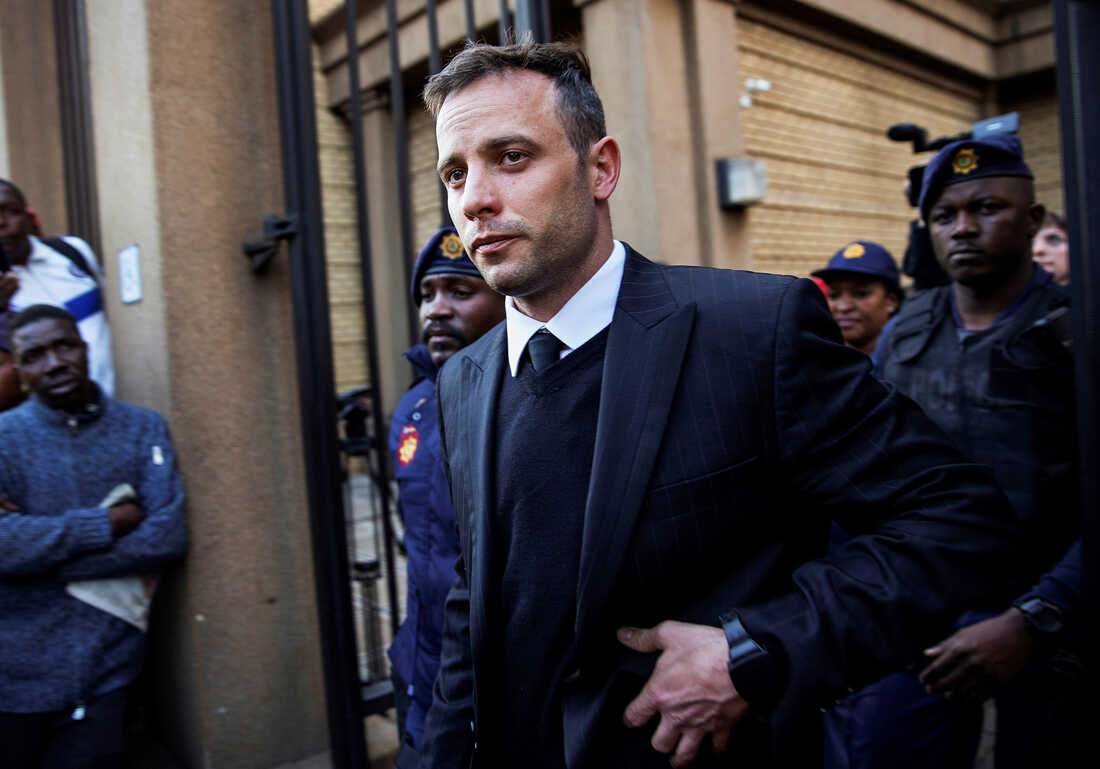Ex-Olympic South African Runner Oscar Pistorius convicted for the tragic shooting of his girlfriend Reeva Steenkamp on Valentine’s Day over a decade ago, is set to be released on parole. The event drew attention from media crews gathering outside the Atteridgeville Correctional Center in Pretoria. Despite anticipation, the Department of Corrections kept his release time undisclosed. It was necessary to shield Pistorius from the media attention that has followed him since the incident.
The officials’ plan involves transferring the 37-year-old Pistorius to a corrections department office for processing before his official release on parole. His initial residence is expected to be his uncle’s estate in the upscale Waterkloof suburb. He previously stayed there during his trial and subsequent house arrest from 2015 to 2016. To prepare for his arrival, bright yellow traffic barriers now block the road leading to his uncle’s house.
Parole Conditions for the Ex-Olympic South African Runner Oscar Pistorius’s Release from Prison

In November, Pistorius, after his second application, gained approval for parole. After serving nine years of his 13-year and five-month sentence for Steenkamp’s murder, he is eligible as per South African guidelines allowing serious offenders parole after completing at least half of their term.
The Department of Corrections outlined stringent conditions for the multiple Paralympic champions. This is until his sentence concludes in December 2029, and he will adhere to strict oversight. Stressing that parole doesn’t equate to the completion of his sentence, the department highlighted the specifics of his parole terms. These include limited outings from his residence, a prohibition on alcohol consumption, compulsory participation in anger management and anti-violence programs, and community service obligations.
Pistorius faces regular home and office meetings with parole officials and unannounced visits from authorities. His movements are confined to the Waterkloof district without prior permission. Also, communication with the media is barred until his sentence ends. Any violation of parole conditions could lead to his return to prison.
South Africa’s Department of Corrections clarified that Pistorius won’t wear any tracking device. However, an appointed official will monitor him continuously. Additionally, any significant life changes, like job pursuits or relocation, require immediate reporting to this official.
Why did Ex-Olympic South African Runner Oscar Pistorius Shoot his Girlfriend?
Pistorius consistently maintained that the fatal shooting of Steenkamp, a 29-year-old model and law graduate, was an accident. According to his testimony, he mistook her for a dangerous intruder hiding in his bathroom. Thus, firing multiple shots through the door in what he believed was an act of self-defence. However, prosecutors argued that the killing was intentional, alleging it occurred during a late-night dispute.
Despite this narrative, Steenkamp’s family didn’t oppose Pistorius’s parole application in November. June Steenkamp, her mother, expressed skepticism in a victim statement submitted to the decision-making board. She felt Pistorius hadn’t undergone complete rehabilitation and continued to be untruthful about the incident.
Pistorius inspired many athletes in South Africa and beyond. He triumphed over the amputation of both legs below the knee due to a congenital condition. His achievements as a Paralympic sprinter using carbon-fibre running blades and his historic participation in the 2012 London Olympics earned him admiration, and perceived as humble.
However, his murder trial shattered this public image, revealing a darker aspect of his life. Accusations surfaced of his alleged propensity for angry outbursts and reckless behavior with firearms. Witnesses testified about multiple confrontations, including an incident where he purportedly threatened violence against another individual.
The Sentencing Process
Pistorius initially faced a conviction of culpable homicide, akin to manslaughter, resulting in a five-year prison sentence for Steenkamp’s death. However, subsequent appeals by prosecutors led to a revised ruling of murder. Despite this, the Supreme Court of Appeal didn’t definitively establish whether Pistorius was aware that Steenkamp was behind the toilet door.
His journey through the legal system saw him enter prison in 2014, then placed under house arrest during an appeal in 2015, followed by a return to prison in 2016. Initially housed in the high-security Kgosi Mampuru II Prison in Pretoria, Pistorius later relocated to Atteridgeville due to its better facilities for disabled inmates.
The response to Pistorius’ parole in South Africa is subdued compared to the intense outcry witnessed in the aftermath of Steenkamp’s killing. The initial fervent protests outside Pistorius’ court hearings demanding a lengthy prison term have subsided, reflecting the absence of the death penalty in South Africa.
Themba Masango, the secretary general of ‘Not In My Name International’, a group advocating against violence towards women, believed that Pistorius met all the requisites. Expressing hope for Pistorius to emerge as a better individual, Masango emphasized the potential for rehabilitation.
Bottomline
Oscar Pistorius was a hero, before his arrest and subsequent conviction for the murder of his model girlfriend. A source of inspiration for countless individuals globally.
Pistorius underwent lower leg amputation during infancy. He later rose to prominence as an Olympic sprinter, for his cutting-edge prosthetics that led to his moniker, “Blade Runner.”



